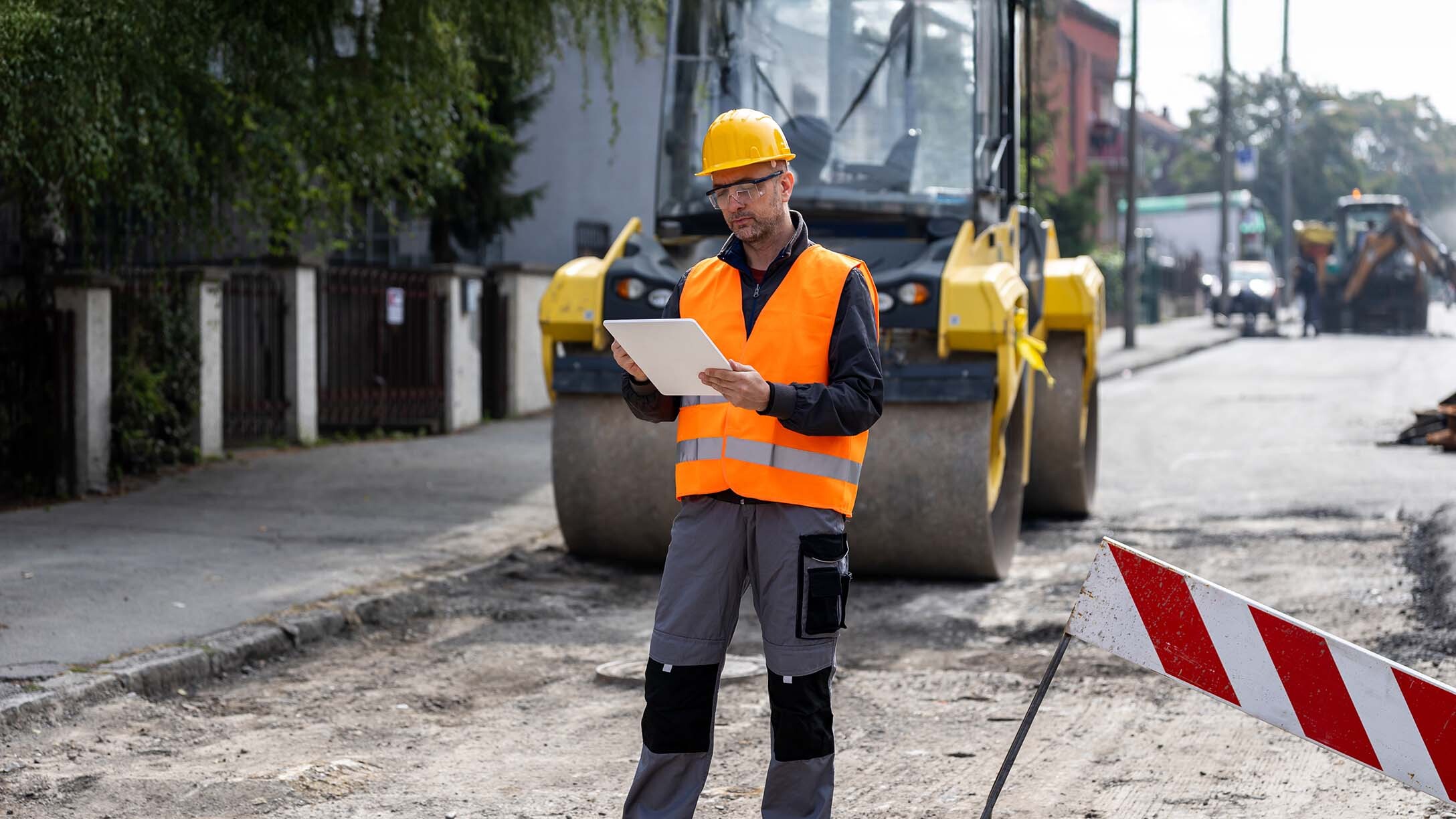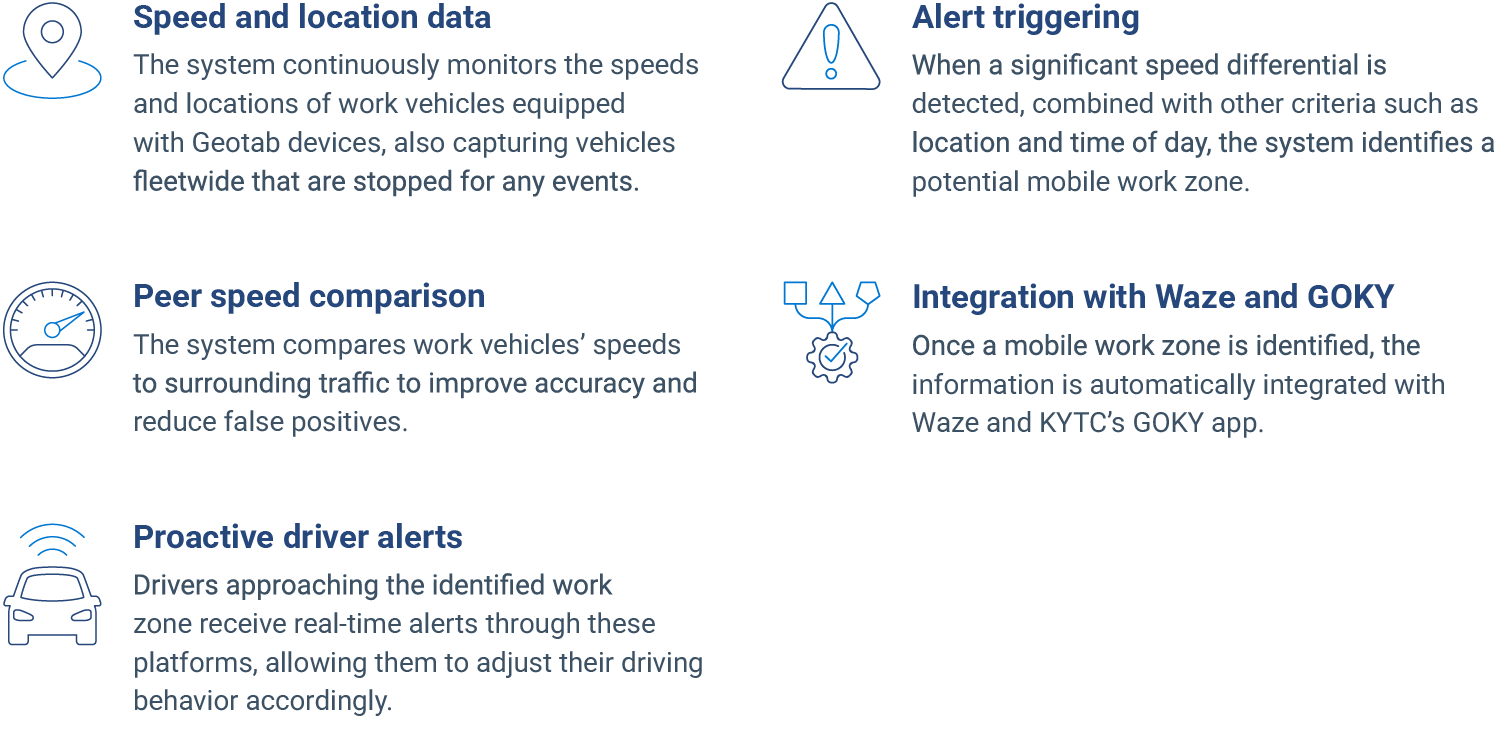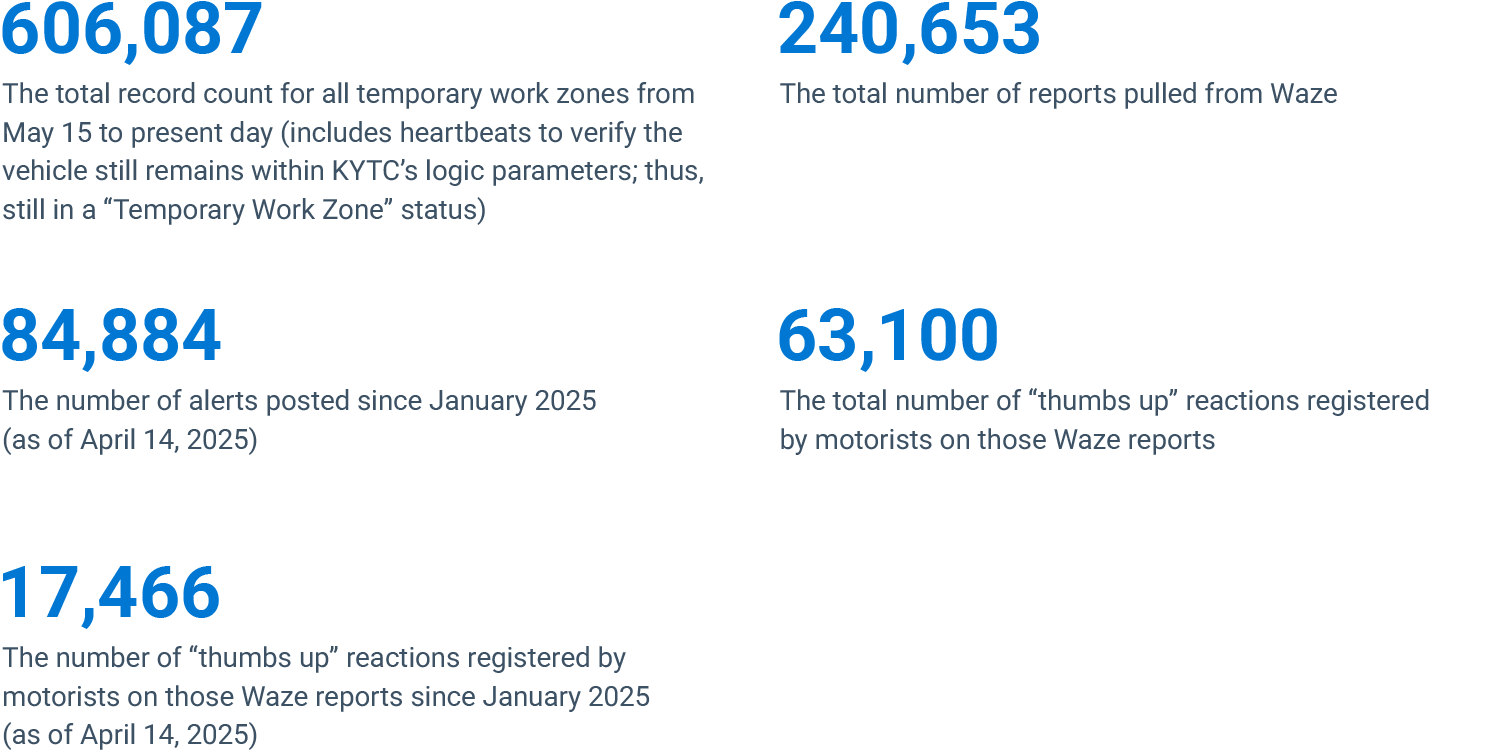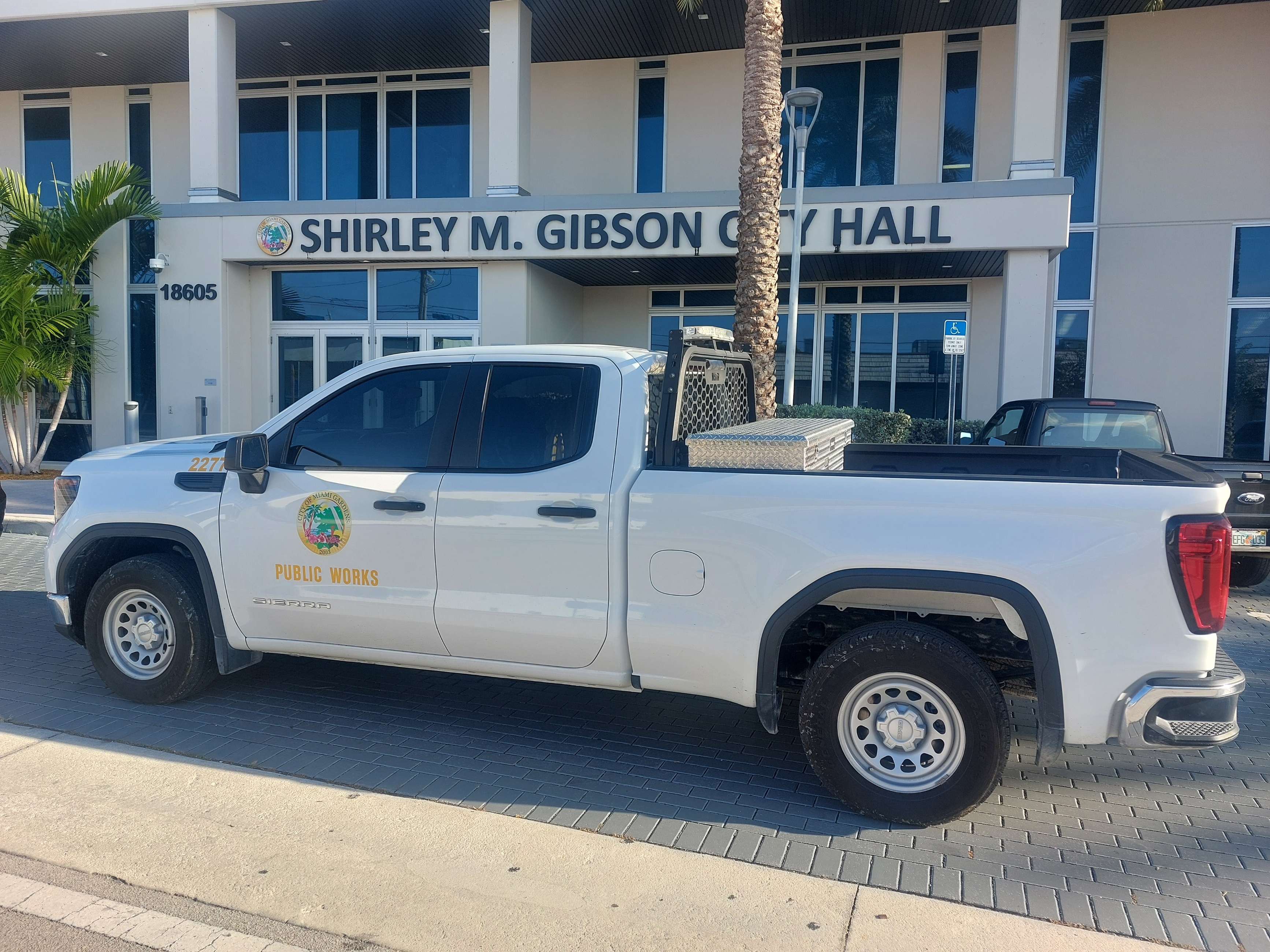
Kentucky Transportation Cabinet: Revolutionizing mobile work zone safety

Table of Contents
- The challenge of short-term mobile work zones
- Bridging gaps in KYTC work zone management processes
- KYTC's mobile work zone solution methodology
- Metrics for evaluating the program’s effectiveness
- KYTC’s future plans for its mobile work zone safety initiative
- Be part of the solution for safer roads
- About Geotab
In the blink of an eye, lives can change forever on our highways. As distracted driving continues to plague our roads, the Kentucky Transportation Cabinet (KYTC) faces an urgent challenge: protecting both motorists and the men and women who work tirelessly to maintain our infrastructure. With construction and maintenance activities becoming increasingly frequent, a dangerous disconnect has emerged between drivers and the work zones. Too often, motorists are confronted with orange cones and flashing lights, leading to various issues, from sudden braking and collisions to increased congestion and heightened frustration among drivers.
Existing alert systems require additional budget and in-vehicle real estate - two things that are in short supply. With space inside vehicles being a premium resource, KYTC wanted to leverage their existing investments with little to no additional cost to drive positive change. This whitepaper explores KYTC's innovative journey to bridge this critical communication gap with an integrated mobile alert system that provides real-time work zone information to improve road safety for drivers and workers alike.
The challenge of short-term mobile work zones
KYTC has developed a robust system for managing long-term construction projects, encompassing all stages from procurement to execution. This comprehensive approach enables efficient reporting of major work zones to the Traffic Operations Center (TOC) and GOKY, Kentucky's 511 system. As a result, drivers are well-informed about long-term construction events.
While long-term projects are more predictable and easier to plan for, short-term work zones present unique challenges. These brief activities, often lasting less than three days and sometimes only a few hours, include pothole repair and weekend tire debris collection. Adding to this complexity are mobile work zones, which involve continuously moving operations. The transient nature of these short-term and mobile work zones makes it difficult for road crews to consistently report rapidly changing conditions to the TOC. Consequently, providing real-time information to drivers about potential hazards becomes a significant challenge, highlighting the need for innovative solutions to enhance communication and safety in these dynamic work environments.
These challenges in managing mobile work zones contribute to a broader national issue of work zone safety, as evidenced by recent trends in collision and fatality rates.
Alarming uptick in work zone collisions nationwide
The challenges of managing and communicating about mobile work zones have contributed to a troubling national trend of increasing work zone safety incidents. This rise is particularly concerning, given the critical nature of road maintenance and construction activities. The transient nature of mobile work zones, combined with the prevalence of distracted driving, creates a perfect storm for potential collisions as drivers navigate constantly changing road conditions.
Smartphone use and in-vehicle entertainment systems have led to a surge in distracted driving incidents. This problem is particularly acute in work zones, where sudden changes in traffic patterns require heightened attention from drivers.
Recent statistics paint a grim picture of the consequences. Fatality data from the Bureau of Labor Statistics (BLS) shows an average of 54 worker-pedestrians are killed per year after being struck by vehicles in work zones.
The year 2023 marked a devastating milestone for the state of Kentucky, recording the worst year on record with 17 fatalities and 23 serious injuries in work zones. This sharp increase underscores the need for improved safety measures and communication strategies. Alarmingly, the trend shows no signs of abating, with 2024 already off to a concerning start, reporting seven fatalities and 31 serious injuries in work zones.
Bridging gaps in KYTC work zone management processes
With rising work zone incidents nationwide, transportation departments have grappled with promoting safety in dynamic road environments. The Kentucky Transportation Cabinet (KYTC) found itself at the forefront of this issue, recognizing that traditional methods of work zone management were no longer sufficient to protect workers and motorists alike.
KYTC's existing system relied heavily on manual reporting of construction projects, which proved inadequate for the fast-paced nature of modern road work. This approach left significant gaps in communication, particularly for short-term or mobile work zones that could appear and disappear within hours. The limitations became increasingly apparent as the department struggled to provide timely alerts to drivers, often leaving motorists unprepared for sudden changes in road conditions.
Recognizing the need for a paradigm shift, KYTC set out to change their approach to work zone safety. The goal was to move beyond the reactive measures of the past and embrace a proactive strategy that could keep pace with the fluid nature of contemporary road maintenance. This initiative aimed to harness the power of real-time data and existing technology to create a more responsive and effective system for managing work zone safety.
The transformation KYTC envisioned wasn't just about implementing new technology; it was about fundamentally changing how they approached road safety. By focusing on rapid identification and reporting of mobile work zones, coupled with instant driver alerts, KYTC sought to create a model that could adapt to the ever-changing landscape of road work. This innovative approach not only promised to enhance safety within Kentucky but also offered potential solutions to the broader challenges facing transportation departments nationwide in their quest to reduce work zone accidents and fatalities.
KYTC's mobile work zone solution methodology
KYTC's approach combined the expertise of their traffic and safety teams to create an effective mobile work zone solution. This collaboration helped make sure the solution was both technically sound and practical.
Instead of investing in new hardware, KYTC leveraged its existing Geotab telematics infrastructure. This ingenious approach turned the agency's existing Geotab telematics system into a powerful work zone safety tool. By tapping into real-time vehicle data, KYTC automated work zone notifications without new hardware or driver input. This clever use of resources slashed costs and implementation time, helping them extract more value from its current tech investments.
Technical implementation details
The core of KYTC's solution lies in its intelligent use of telematics data.

Identifying mobile work zones
The system's ability to accurately identify mobile work zones is crucial to its success. Key factors in this process include:

“Sometimes the best innovations come from using what you already have in new ways. We've created a cost-effective, easily repeatable approach to work zone safety by tapping into existing telematics data and fostering team collaboration. This is a prime example of how we can drive significant improvements in transportation safety and efficiency through creative thinking and strategic use of data." - Erica Russell, ITS Technical Team Lead, Division of Maintenance, Kentucky Transportation Cabinet
Metrics for evaluating the program’s effectiveness
KYTC has established several key metrics to grade how well its mobile work zone solution is performing. The primary goal is to reduce work zone-related incidents by 30% within the first year of implementation while increasing driver compliance with safety measures. While the project is still in its early stages, initial results are promising:

KYTC's initial metrics reveal encouraging signs of success, particularly in public engagement. The substantial number of Waze reports and "thumbs up" reactions from motorists indicates a high level of awareness and interaction with the mobile work zone alerts. This active participation suggests that drivers are not only receiving the alerts but are also acknowledging and validating them, which points towards a positive shift in driver behavior and increased vigilance around road maintenance work zones.

KYTC’s Safety Report Table that notates where mobile work zones in the field are located. From January 1, 2025 to April 15, 2025, 84,884 records were counted.

A screenshot of KYTC’s system that displays record counts by route. Their team uses this dashboard to track total reports and monitor their mobile work zone safety program’s effectiveness.
KYTC’s future plans for its mobile work zone safety initiative
KYTC is dedicated to expanding and enhancing its mobile work zone safety solution. The organization plans to integrate the system with additional traffic management platforms and extend coverage to a broader range of work vehicle types. Furthermore, KYTC aims to explore predictive analytics to improve safety measures further. A key focus is the expansion to secondary roads, which will require developing tailored logic to address the unique challenges of less trafficked areas, particularly regarding speed comparisons.
Technological advancements play a crucial role in KYTC's future plans. The organization intends to collect user feedback, investigate AI and machine learning applications, and integrate the system with navigation apps and connected vehicle technology. Additionally, KYTC recognizes the importance of public engagement and plans to launch awareness campaigns, create educational materials and partner with driving schools to promote work zone safety.
KYTC continues to consider the broader applications of their solution, including improving emergency service response times. The organization is also developing plans for nationwide implementation and exploring potential international partnerships. Throughout this process, KYTC remains motivated by the tragic loss of a young state employee, using this incident as a reminder of the project's importance and its potential to save lives.
Be part of the solution for safer roads
The success of KYTC's approach should serve as an inspiration and blueprint for other transportation agencies facing similar challenges. We encourage other agencies to:
- Evaluate their existing technological infrastructure for untapped potential
- Collaborate across departments to develop innovative solutions
- Prioritize proactive safety measures, especially for unpredictable work environments
Share best practices and lessons learned to collectively improve road safety nationwide
“Every life lost in a work zone is one too many. Buckle up, put the phone down, and stay alert – our workers' families are counting on you.”- Randi Feltner, Assistant Director, Division of Maintenance
Kentucky Transportation Cabinet
Following KYTC's lead and embracing technology-driven solutions, we can work together to make our roads safer for everyone, one work zone at a time.
About Geotab
Geotab partners with the public sector to provide secure, connected fleet management solutions that you can rely on to drive efficiency and cost savings. For the fourth year in a row, ABI Research has ranked Geotab the #1 Global Telematics Vendor. Our web-based analytics, open platform and Marketplace help our customers optimize fleet performance and unlock insights to improve safety, utilization, maintenance, fuel management and sustainability.
At Geotab, we understand the complexities of managing public sector fleets. We're not just a technology provider; we're a dedicated partner firmly committed to your success.
To learn more about what Geotab can do for your public works department, talk to us to set up a free 1:1 consultation.
Post Tags
Client profile
Client name:
Kentucky Transportation Cabinet
Industry:
Department of Transportation
Types of vehicles:
Mix
Fleet size:
6000+
Fleet focus:
Safety
Other stories

City of Miami Gardens: Cutting costs, saving lives with Smart Fleet Management
November 4, 2025

Holman and White Cap: data-driven fleet safety at scale
July 25, 2025

ENMAX Power Corporation unlocks real-time insights on fleet performance with telematics
April 9, 2025

Gerhardt Group: Digging into telematics data to drive efficiency
January 16, 2025